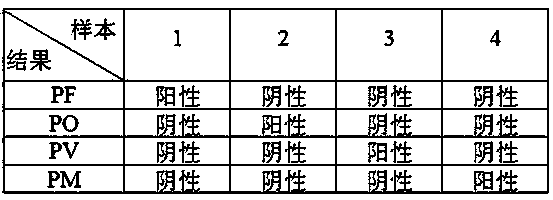Primers, probes and method for detecting plasmodium
A Plasmodium and probe technology, applied in the direction of microorganism-based methods, biochemical equipment and methods, microorganisms, etc., can solve the problems of time-consuming and labor-intensive blood smear inspection methods, complex detection condition settings, low specificity and sensitivity, etc. , to achieve the effect of fast detection speed, stable results and high sensitivity
- Summary
- Abstract
- Description
- Claims
- Application Information
AI Technical Summary
Problems solved by technology
Method used
Image
Examples
Embodiment 1
[0028] Example 1: Design and synthesis of primers and probe sequences
[0029] Search for the sequence of the target gene SSUrRNA of the malaria parasite pathogen from Genebank, use relevant bioinformatics software for homology analysis and BLAST sequence analysis, screen out highly conserved regions, and use the primer design software Primer Premier 5 for the conserved sequences to carry out primers and probes After the design of primers and probes, use NCBI BLAST to test the specificity, and use Primer premier 5 to detect whether there is a hairpin structure or dimer formation. The results show that the designed probes meet the specificity requirements and will not form Hairpin structure or dimer. The designed primers and probe sequences are listed in Table 1.
[0030] Table 1 Primers and probes used to detect Plasmodium
[0031] name sequence SEQ ID No: PU-F2 TTGTTGCAGTTAAAACGCTCG 1 PU-R2 GCTTTGAACACTCTAATTTACTC 2 PV-PF2 GCAACGCTTCTTA...
Embodiment 2
[0032] Example 2 . Preparation of Four Plasmodium-specific Probe Microsphere Sets
[0033] 1. Probe synthesis
[0034] Various probe sequences were synthesized according to SEQ ID No: 3-6 in Table 1, and the 5' ends of all probes were modified with amination and connected with a C12 adjacent arm sequence.
[0035] 2. Coupling of probes and microspheres
[0036] Randomly select 4 different fluorescent microspheres, the numbers of the selected fluorescent microspheres in this embodiment are 45, 49, 52, 56, provided by BioRad, and the nucleic acid probes are coupled according to the following method:
[0037] 1. Put 4 types of microspheres numbered 45, 49, 56, and 52 stored at 2-10°C and 2 bottles of unopened EDC powder (10mg / bottle) stored at -20°C at room temperature for 30-60 minutes;
[0038] 2. The PV-PF2, PM-PF2, PO-PF2, PF-PF2 nucleic acid probes were respectively separated by ddH 2 O is dissolved at a concentration of 0.1 nmol / μl;
[0039] 3. Vortex the microsphe...
Embodiment 3
[0062] Example 3 : Detection of Plasmodium in 4 clinical samples
[0063] 1. Sample preparation
[0064] The genomic DNA of No. 1-4 clinical samples was extracted by conventional methods, and the concentration was measured for future use. The clinical samples could be serum or mosquitoes. In this embodiment, human serum was selected as the test sample.
[0065] 2. Multiplex PCR amplification
[0066] 1. Synthesize PCR amplification primers according to SEQ ID No: 1-2 in Table 1, wherein the 5' ends of the downstream primers all have biotin modification
[0067] 2. PCR amplification reaction:
[0068] (1) PCR reaction system: PCR amplification reaction system is 20 μl, including 10×PCR Buffer 2 μl, dNTP (2.5 mmol / L) 2 μl, goldTaq enzyme (5U / μl) 0.07 μl, PU-F2 (5 μM) 0.3 μl , PU-R2 (5μM) 1.5μl, genomic DNA 1μl, add ddH 2 O 11.6μl to a final volume of 20μl; at the same time, set up a negative control group, with 1μl ddH 2 O is a template instead of genomic DNA;
[0...
PUM
 Login to View More
Login to View More Abstract
Description
Claims
Application Information
 Login to View More
Login to View More - R&D
- Intellectual Property
- Life Sciences
- Materials
- Tech Scout
- Unparalleled Data Quality
- Higher Quality Content
- 60% Fewer Hallucinations
Browse by: Latest US Patents, China's latest patents, Technical Efficacy Thesaurus, Application Domain, Technology Topic, Popular Technical Reports.
© 2025 PatSnap. All rights reserved.Legal|Privacy policy|Modern Slavery Act Transparency Statement|Sitemap|About US| Contact US: help@patsnap.com


